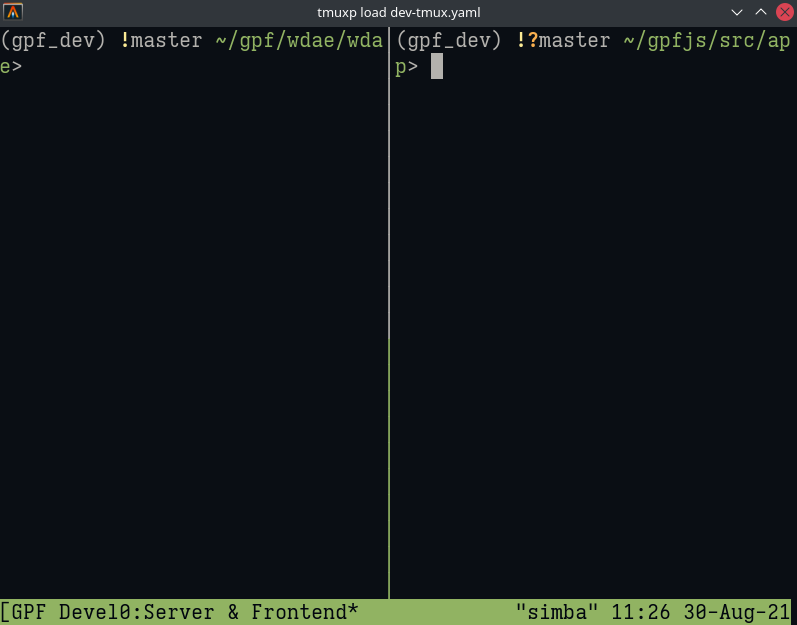Quick GPF dev env terminal with tmuxp¶

This is a short guide on setting up a quick dev env terminal for GPF with two panes for wdae and gpfjs.
Install tmux and tmuxp (https://github.com/tmux-python/tmuxp)
sudo apt-get update -y sudo apt-get install -y tmuxp
Create a
dev-tmux.yamlfile in your home directory with the following content, adjusting the filepaths where necessary:
session_name: GPF Development windows: - window_name: Server & Frontend layout: even-horizontal shell_command_before: - source /home/$USER/setenv.sh # set environment shell script - export TERM=screen-256color # colors panes: - shell_command: - cd /home/$USER/gpf/wdae/wdae # wdae - clear - shell_command: - cd /home/$USER/gpfjs/src/app # gpfjs - clear
Run
tmuxp load dev-tmux.yamlfrom your home directory.
NOTE: If
cleardoes not completely clear your terminal, you can use reset at the cost of a slightly slower startup.
Quick build_setup - clears build-env/ folder, downloads latest successful build env and runs build_setup.sh. Example below is for gpf and gpf-e2e (2 panes). Remove shell_command sections if needed only for gpf
Create a
build-setup-tmux.yamlfile in your home directory:
session_name: gpf/gpf-e2e setup windows: - window_name: Server & Frontend layout: even-horizontal shell_command_before: - source /home/$USER/setenv.sh - export TERM=screen-256color panes: - shell_command: - setopt localoptions rmstarsilent - cd /home/$USER/gpf - reset - git pull --recurse-submodules - rm build-env/* - wget -q -O build-env/iossifovlab.gpf.combined-input.build-env.sh --auth-no-challenge --http-user=${jenkins_username} --http-password=${jenkins_auth_token} --no-cache https://nemo.seqpipe.org/job/iossifovlab/job/gpf/job/master/lastSuccessfulBuild/artifact/build-env/iossifovlab.gpf.combined-input.build-env.sh - ./build_setup.sh - shell_command: - setopt localoptions rmstarsilent - cd /home/$USER/gpf-e2e - reset - git pull --recurse-submodules - rm build-env/* - wget -q -O build-env/iossifovlab.gpf-e2e.combined-input.build-env.sh --auth-no-challenge --http-user=${jenkins_username} --http-password=${jenkins_auth_token} https://nemo.seqpipe.org/job/iossifovlab/job/gpf-e2e/job/master/lastSuccessfulBuild/artifact/build-env/iossifovlab.gpf-e2e.combined-input.build-env.sh - ./build_setup.sh
3. Generate Jenkins token by navigating to
https://nemo.seqpipe.org/user/${jenkins_username}/configure
and clicking on ‘Add new Token’ button under the ‘API Token’ section.
Replace ${jenkins_username} and ${jenkins_auth_token} in the wget commands with your jenkins username and token.
To run:
tmuxp load build-setup-tmux.yaml
User friendly tmux config:
~/.tmux.conf# switch pane on mouse click set -g mouse on # starting window index at 1, instead of 0 set -g base-index 1 # alt-arrow keys without prefix key to switch panes bind -n M-Left select-pane -L bind -n M-Right select-pane -R bind -n M-Up select-pane -U bind -n M-Down select-pane -D # switch panes with alt+q/e bind-key -n M-q select-pane -L bind-key -n M-e select-pane -R # create panes with e and s bind-key e split-window -h bind-key s split-window -v # theme set -g status-bg colour29 set -g status-fg white
